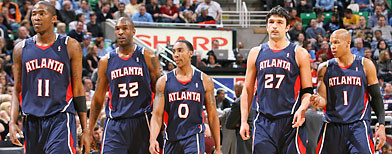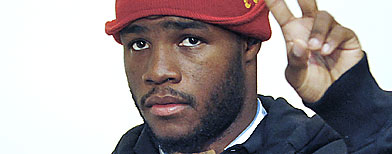From Yahoo Sports:
Super Bowl is most watched TV show ever
NEW YORK (AP)—The
New Orleans Saints’ victory over Indianapolis in the Super Bowl was watched by more than 106 million people, surpassing the 1983 finale of “M-A-S-H” to become the most-watched program in U.S. television history, the Nielsen Co. said Monday.
Compelling story lines involving the city of New Orleans and its ongoing recovery from Hurricane Katrina and the attempt at a second Super Bowl ring for Indianapolis quarterback
Peyton Manning(notes) propelled the viewership. Football ratings have been strong all season.
“It was one of those magical moments that you don’t often see in sports,” said Sean McManus, president of CBS News and Sports.
Nielsen estimated Monday that 106.5 million people watched Sunday’s Super Bowl. The “M-A-S-H” record was 105.97 million.
The viewership estimate obliterated the previous record viewership for a Super Bowl—last year’s game between Arizona and Pittsburgh. That game was seen by 98.7 million people, Nielsen said.
The “M-A-S-H” record has proven as durable and meaningful in television as Babe Ruth’s record of 714 home runs was in baseball until topped by Hank Aaron. Ultimately, it may be hard to tell which program was really watched by more people. There’s a margin for error in such numbers, and Nielsen’s Monday estimate was preliminary, and could change with a more thorough look at data due Tuesday.
“It’s significant for all of the members of the broadcasting community,” said Leslie Moonves, CBS Corp. CEO. “For anyone who wants to write that broadcasting is dead, 106 million people watched this program. You can’t find that anywhere else.”
Moonves predicted CBS will earn more in advertising revenue than in any other Super Bowl. The good ratings for the game and football in general also set CBS and other football broadcasters up well when selling advertising for next season, he said.
The Nielsen estimate also drew some congratulations from Alan Alda, the star of “M-A-S-H,” and the slugger whose record was beaten.
“If the `M-A-S-H’ audience was eclipsed, it was probably due in large part to the fact that the whole country is rooting for New Orleans to triumph in every way possible,” Alda said. “I am, too, and I couldn’t be happier for them. I love that city.”
There are more American homes with television sets now (114.9 million) than there were in 1983 (83.3 million). An estimated 77 percent of homes with TVs on were watching “M-A-S-H” in 1983, compared with the audience share of 68 for the Super Bowl.
Nielsen also measures only the United States, and it’s possible some World Cup soccer games were seen more worldwide. Accurate measurement of television audiences outside the United States is spotty at best.
Alda also wondered whether the numbers were too close to declare a new champion. He thinks Nielsen didn’t take into account large numbers of people watching “M-A-S-H” communally, which is often the case for football games, too.
“Not to say I’m competitive, but in part we are talking about sports,” he said. “And I actually AM competitive.”
McManus didn’t want to jinx it, but the abnormally strong viewership for football this year left him hoping for a record. The NFC and AFC championship games both had their biggest audiences since the 1980s. The growth of high-definition television and its appeal to sports fans has also helped.
A competitive game until the final minutes sealed it. McManus acknowledged some nervousness when Indianapolis jumped out to a 10-0 lead—a Super Bowl rout often makes people turn away from the game—but New Orleans roared back.
The Mid-Atlantic blizzard also helped CBS. After New Orleans, the highest-rated market was snowbound Washington, Nielsen said. More people watched the game from their homes in that area instead of going to parties or bars, and Nielsen does a much better job counting viewers in homes than outside of them.
“Bad weather in the Northeast and good weather in Florida was a good combination for us,” McManus said.
The Super Bowl also proved a strong launching pad for the new CBS series “Undercover Boss” that premiered after the game. An estimated 38.6 million people watched the first edition of a series about corporate honchos working secretly as low-level employees in their own companies, Nielsen said. That’s third only to a 1996 “Friends” and 2001 “Survivor” as the most-watched program after the Super Bowl.
Meanwhile, Dorito’s was a big winner in a measurement of interest in the commercials played during the Super Bowl. TiVo Inc. said the snack company’s ad featuring a boy telling a man to keep his hands off his chips and his mom was stopped and played back in 15 percent of homes with the digital video recorder.
The secretly filmed CBS promo with David Letterman, Jay Leno and Oprah Winfrey came in second, followed by the Snicker’s ad with Betty White and Abe Vigoda flattened in a football game.
In general, however, TiVo found less interest in the commercials than it has in previous years, judged by how many people paused live action to see them, said Todd Juenger, general manager of TiVo’s research department.




















 Kobe Bryant chose not to mix with scantily-clad women last night, and the night club that threw the shindig he was scheduled to host is pissed.
Kobe Bryant chose not to mix with scantily-clad women last night, and the night club that threw the shindig he was scheduled to host is pissed.









 Former NFL star Warren Sapp was arrested by Miami Beach police this afternoon and charged with misdemeanor domestic battery stemming from an allegedly violent confrontation with his girlfriend.
Former NFL star Warren Sapp was arrested by Miami Beach police this afternoon and charged with misdemeanor domestic battery stemming from an allegedly violent confrontation with his girlfriend.  Former NFL star Warren Sapp is being questioned by Miami Beach police in connection with a domestic violence case.
Former NFL star Warren Sapp is being questioned by Miami Beach police in connection with a domestic violence case. 








